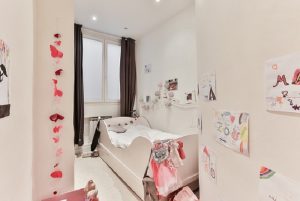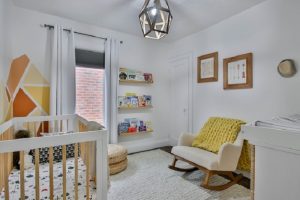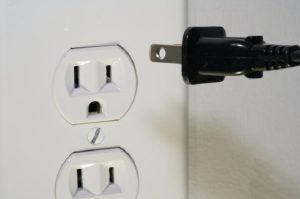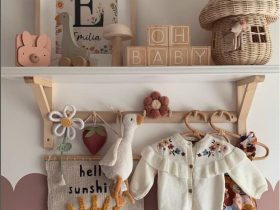If you’re expecting a new baby, decorating your nursery can be a lot of fun. But it’s also important to remember that your new addition will need extra safety precautions in their room. It’s essential to keep things simple and easy to clean so that you’ll be able to easily clean up any messes and keep harmful chemicals out of reach at all times.
Here are some tips for designing and babyproofing your nursery:
Keep Things Simple

Decorating a nursery is fun and exciting; you can do some things at once. Don’t worry if you need more details about the chosen theme or color scheme. You can add items as you go or wait until your baby is born to make final decisions.
Read More: Nursery Shelves Ideas
Make It Sensible

To keep your baby safe, you’ll want to make sure that furniture and other objects are out of his reach. It would be best to keep things within reach at a child’s level. If you have stairs in your home, use safety gates to block them off until the baby is old enough not to climb them.
Avoid placing sharp objects in the baby’s reach, as they can cause injury if they fall onto him while he sits on the floor or crawls around your house. Keep cords such as telephone wires and electrical cables out of sight so that he won’t chew on them or trip over them when he crawls around the room. Finally, keep chemicals such as cleaning products out of his reach as well; these could be harmful if consumed by babies who aren’t toilet trained yet.
Choose Your Walls Wisely

Before you begin designing your nursery room wallpaper, there are a few things you need to consider about the walls:
First: is your wall easily washable? If it’s not, you might want to reconsider your choice of wall color—because babies tend to make messes with paint, food, and other substances. A good rule of thumb is that if there are stains on it now, there will be more later with a baby in the house!
Second: does the pattern match what you want for your decorating theme? The last thing you want is an off-color pattern that stands out like a sore thumb when viewed alongside your other decorations.
Third: how will this affect how much light comes into the room during the daytime? If it blocks out too much natural light coming through windows (or doors), consider changing the direction these items face when compared against each other within their respective rooms.
Go Low When Decorating the Ceiling
If you have a mirror, use a hook-and-loop fastener to hang it on the wall instead of the ceiling. If you have a chandelier, use a hook-and-loop buckle to turn it on the wall instead of the ceiling. You can also use them for any other items that might be tempting for your baby to reach for, such as lights or plants.
Choose a wide, spongy border
A spongy border is a great way to protect your walls from baby bumps and scratches. It’ll also help keep the room looking pretty since it comes in many colors and patterns.
It’s easy to clean—you can wipe up spills immediately without damaging the finish on your wall. And it’s safe for babies: soft edges won’t hurt little hands, and there won’t be any sharp corners for them to bump into. Finally, installing one is easy: just peel off the backing from the adhesive strip and stick it on!
Invest in Soft Flooring

If you’re planning on a nursery, one of the most important things to consider is your flooring. You want soft flooring for safety, convenience, and comfort. Parents and pets will appreciate not worrying about hard corners or sharp edges from bare floors. Babyproofing with soft flooring also protects the environment by reducing waste from disposable furniture pads or carpets glued with adhesives that may be harmful when they come off later on (and they will).
Watch Out for Chemicals
As you prepare your nursery, you’ll want to consider the chemicals used in the room. Baby-proofing can mean a lot of things, but one thing it certainly doesn’t mean is exposing your baby to harmful chemicals.
Because it’s so important to keep your little one safe from toxins and other hazards, avoid using paint or varnish when decorating their room. Instead, opt for non-toxic paints and varnishes when choosing colors for walls and furniture. If possible, avoid chemicals altogether by using natural alternatives like vinegar instead of bleach for cleaning surfaces and cotton balls soaked in coconut oil instead of petroleum jelly on furniture legs—these are just some ideas!
Covering outlets is OK, but don’t do it with wallpaper

While it is generally considered acceptable to cover outlets in your baby’s room with outlet covers, they should not be covered with wallpaper. Many types of outlet covers can be used as an alternative, including:
- Plastic outlet cover— This cover goes over the socket and screws into place. It may come with a safety switch, which will allow for a temporary power source if you have an older child who needs to use it for daycare or other purposes. You can also purchase this item without a safety switch if you do not need one.
- Outlet cover with a safety switch— These outlet covers include a small button beneath them that must be pushed before they will turn on or off. They are designed to prevent children from turning off power sources on high ground or standing near the water to avoid electrocution hazards.
- Outlet cover with a switch operated by the child— This type of product comes equipped with buttons activated by pressing down on them, similar to how light switches work in homes today (though usually much larger). These can be very useful for young children who want complete control over their environment but may not yet have the talent needed to grip these kinds of buttons properly yet; however, because these do not require any sort of pressure from either parent or child before engaging/disengaging themselves automatically after being pressed once each time respectively means there still exists some risk associated
Conclusion
When it comes to babies, there is a lot of advice out there about how to keep them safe. Even though it might seem easy at first, there is a lot you can do to make your nursery room safe for your baby without making it look like a second office. In fact, if you can use some of these ideas in your design, you might end up with a nursery that looks even better than you thought possible.











Leave a Review